How Do You Get Type 2 Diabetes?

How do you get type 2 diabetes? In a world where sugar is king and exercise often takes a back seat, understanding the onset of this condition is crucial. We’ll explore the various factors contributing to the development of type 2 diabetes, from genetics and lifestyle choices to obesity and environmental influences.
Genetics and Family History
Role of Genetics in Type 2 Diabetes
Genetics isn’t just about inheriting your grandma’s blue eyes; it’s also about the invisible traits that could make you susceptible to type 2 diabetes. Research shows that specific genes can influence insulin resistance, insulin secretion, and obesity, all of which are linked to diabetes. If your family has a history of diabetes, it’s like being handed a loaded genetic dice.
Family History as a Risk Factor
Your family history is like a mirror reflecting potential futures. It’s not just about genes but also lifestyle habits, dietary choices, and even how stress is managed—all of which can be passed down through generations and contribute to diabetes. If your parents or siblings have diabetes, you’re more likely to develop the condition.
Facts and Statistics:
Type 2 diabetes has a vital genetic component—more so than Type 1 diabetes.
Lifestyle Factors
Poor Diet Choices
When it comes to what causes diabetes, your plate matters. Foods high in sugar, unhealthy fats, and empty calories are like ticking time bombs for your insulin levels. Consuming processed foods and sugary beverages regularly can lead to weight gain and insulin resistance, setting the stage for diabetes.

Lack of Physical Activity
The couch might be comfy, but it’s also a silent killer. Lack of exercise leads to weight gain and insulin resistance, both of which are stepping stones to diabetes. Studies show that even moderate exercise, like a 30-minute walk each day, can significantly reduce the risk of developing type 2 diabetes.
Facts and Statistics:
Lifestyle factors like poor diet and lack of exercise are significant contributors. You’re more likely to get type 2 diabetes if you are overweight.
Insulin Resistance
Definition and Explanation of Insulin Resistance
“Insulin resistance is when your body’s cells look at insulin and say, “Not today.” This forces your pancreas to work overtime, eventually wearing it out and elevating blood sugar levels. Insulin resistance is often a precursor to type 2 diabetes and can exist in the body for years before the disease is diagnosed.”Insulin resistance is when your body’s cells look at insulin and say, “Not today.” This forces your pancreas to work overtime, eventually wearing it out and elevating blood sugar levels. Insulin resistance is often a precursor to type 2 diabetes and can exist in the body for years before the disease is diagnosed.
Connection to Type 2 Diabetes
Insulin resistance is like the prologue in the tragic story of how you get diabetes. It sets the stage for your body’s inability to manage sugar effectively, leading to full-blown diabetes. Over time, the pancreas can’t keep up with the increased demand for insulin, causing glucose levels in the blood to rise.
Facts and Statistics:
37.3 million Americans—about 1 in 10—have diabetes.
Metabolic Syndrome
Definition and Components of Metabolic Syndrome
Metabolic syndrome is a cocktail of conditions—high blood pressure, high sugar levels, excess body fat—that together sound the alarm for the onset of diabetes. Having just one of these conditions doesn’t mean you’ll get diabetes, but having them together significantly increases the risk.
Its Relation to Type 2 Diabetes Development
“Think of metabolic syndrome as the universe screaming,” Change your lifestyle now, or else!” Each component of metabolic syndrome is a risk factor for diabetes, and together, they create a perfect storm for the disease to thrive.”Think of metabolic syndrome as the universe screaming, “Change your lifestyle now, or else!” Each component of metabolic syndrome is a risk factor for diabetes, and together, they create a perfect storm for the disease to thrive.
Facts and Statistics:
About 1 in 5 people with diabetes don’t know they have it.
Age and Gender
Age as a Risk Factor
As you age, your risk for diabetes increases, not just because of a slowing metabolism but also due to years of accumulated lifestyle choices. After the age of 45, the risk of developing type 2 diabetes rises significantly.
Gender Differences in Type 2 Diabetes
Men may be from Mars and women from Venus, but diabetes doesn’t discriminate. However, women have the added risk of gestational diabetes, which can lead to type 2 diabetes later in life. Additionally, women often carry weight in different areas than men, which can affect diabetes risk.
Facts and Statistics:
The older you get, the greater your risk of type 2 diabetes—especially after age 45.
Quick Poll
Ethnicity and Race
Disparities in Type 2 Diabetes Prevalence
Certain ethnic groups, including African Americans and Hispanic/Latino Americans, are at a higher risk, often due to a combination of genetic and environmental factors. Socioeconomic status, access to healthcare, and even cultural dietary habits can contribute to these disparities.
Factors Influencing These Disparities
Socioeconomic status, access to healthcare, and even cultural dietary habits can contribute to these disparities. Lower-income communities often have less access to healthy food options and healthcare, increasing the risk of diabetes.
Facts and Statistics:
In the United States, type 2 diabetes is more prevalent for certain groups than for white people. These people include Native Americans, Black people, Hispanics, and Asian Americans.
Gestational Diabetes and Pre-diabetes
Gestational Diabetes and Its Connection to Type 2 Diabetes
For women, gestational diabetes is like a red flag, signaling a higher risk of developing type 2 diabetes in the future. About 50% of women with gestational diabetes go on to develop type 2 diabetes later in life.
Pre-diabetes as a Warning Sign
Pre-diabetes is your body tapping you on the shoulder and saying, “Hey, let’s turn things around before it’s too late.” It’s a condition where blood sugar levels are higher than usual but not yet high enough for a diabetes diagnosis. Without intervention, pre-diabetes will likely become type 2 diabetes in 10 years or less.
Facts and Statistics:
Gestational diabetes can increase the risk of developing type 2 diabetes later in life.
Environmental Factors
Exposure to Toxins and Pollution
Believe it or not, even the air you breathe can contribute to diabetes. Toxins and pollutants can cause inflammation, leading to insulin resistance. Studies have shown that exposure to high levels of environmental toxins can increase the risk of developing type 2 diabetes.
Socioeconomic Factors
Your zip code can be as influential as your genetic code regarding diabetes. Lack of access to healthy food and healthcare can significantly increase your risk. Lower-income communities often have less access to healthy food options and healthcare, increasing the risk of diabetes.
Facts and Statistics:
In 2019, about 1.4 million new cases of diabetes were diagnosed.
Stress and Mental Health
The Impact of Chronic Stress
“Stress is like adding fuel to the diabetes fire. It releases hormones that can elevate blood sugar levels. Chronic stress keeps your body in a constant state of”fight or flight,” which can make insulin less effective.”Stress is like adding fuel to the diabetes fire. It releases hormones that can elevate blood sugar levels. Chronic stress keeps your body in a constant state of “fight or flight,” which can make insulin less effective.
Mental Health and Diabetes
Depression and anxiety can lead to poor lifestyle choices, creating a vicious cycle that contributes to diabetes. Emotional eating, lack of exercise, and poor sleep are common issues for people with mental health conditions, all of which can contribute to weight gain and insulin resistance.
Facts and Statistics:
Stress can make managing diabetes harder, including collecting your blood sugar levels.
Conclusion
We’ve unraveled the complex tapestry of what is type 2 diabetes and how it sneaks into our lives. Now, it’s up to you to take action. Your health is in your hands, and every choice you make counts.
PLEASE SHARE YOUR EXPERIENCE AND THE COMMENTS BELOW SO WE CAN HELP EACH OTHER WITH THE KNOWLEDGE YOU HAVE GAINED.
References
- VeryWellHealth. Type 2 Diabetes: Statistics and Facts. https://www.verywellhealth.com/type-2-diabetes-statistics-5214216
- HealthLine. Type 2 Diabetes Statistics and Facts. https://www.healthline.com/health/type-2-diabetes/statistics
- Centers for Disease Control and Prevention. The Facts, Stats, and Impacts of Diabetes. https://www.innerbody.com/diabetes-statistics-in-the-united-states
- NHS Inform. Type 2 diabetes. https://www.nhsinform.scot/illnesses-and-conditions/diabetes/type-2-diabetes
- National Institute of Diabetes and Digestive and Kidney Diseases. Symptoms & Causes of Diabetes. https://www.niddk.nih.gov/health-information/diabetes/overview/symptoms-causes
- Centers for Disease Control and Prevention. What Causes Type 2 Diabetes. https://www.cdc.gov/diabetes/library/features/diabetes-causes.html





